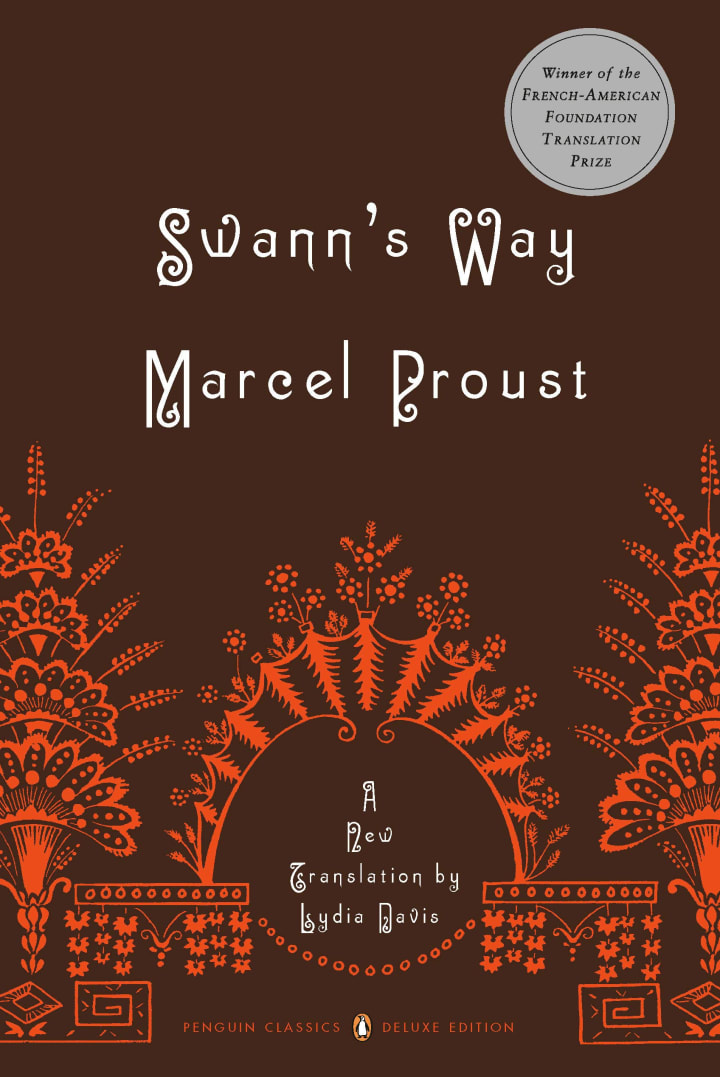
"In Search of Lost Time" (original French title: "À la recherche du temps perdu") by Marcel Proust is a monumental work of literature that spans seven volumes and is often considered one of the most profound and influential novels of the 20th century. Published between 1913 and 1927, Proust's magnum opus delves into the intricacies of human consciousness, memory, love, art, and the passage of time. The novel's exploration of these themes is achieved through rich prose, intricate narratives, and the meticulous dissection of human experience. As we embark on a journey through this literary masterpiece, we encounter characters, settings, and reflections that mirror the complex tapestry of human existence.

Volume 1: Swann's Way
The saga commences with "Swann's Way," immersing readers in the young narrator's memories of Combray, a small French town. The novel's narrative form is a labyrinth of introspection, where the protagonist's memories evoke a cascade of sensations and emotions. Through these reminiscences, Proust introduces us to the concept of involuntary memory, where mundane events or objects trigger profound recollections. The novella also delves into the complex psychology of love, as exemplified by Charles Swann's obsession with the captivating Odette.
Volume 2: In the Shadow of Young Girls in Flower
Continuing the narrative, "In the Shadow of Young Girls in Flower" follows the narrator's transition to adolescence. The story is set against the backdrop of the seaside resort of Balbec, where the protagonist navigates the world of youth, desire, and burgeoning emotions. Through his interactions with various characters, Proust paints a detailed portrait of social dynamics and the intricate nuances of relationships.
Volume 3: The Guermantes Way
"The Guermantes Way" ushers readers into the glamorous world of the aristocracy and the Guermantes family. Proust meticulously dissects societal pretensions, exploring the juxtaposition of public appearances and private lives. Through vivid descriptions and astute observations, the novel delves into the complexities of societal rituals, revealing the characters' motivations, insecurities, and the intricate dance of power and status.
Volume 4: Sodom and Gomorrah
"Sodom and Gomorrah" courageously explores themes of homosexuality, desire, and societal hypocrisy. The volume ventures into uncharted territory, portraying the characters' intimate lives and unveiling the hidden layers of human sexuality. Proust provides a candid examination of the tension between societal expectations and personal inclinations, creating a thought-provoking dialogue about identity, authenticity, and societal norms.
Volume 5: The Captive
Continuing the narrative, "The Captive" delves into the narrator's tumultuous relationship with Albertine, a woman who becomes the focal point of his obsessions. The novel explores themes of possessiveness, jealousy, and the transient nature of emotions. Proust masterfully unravels the complexities of love, revealing how the characters' desires and insecurities shape their interactions and influence their emotional landscapes.
Volume 6: The Fugitive
"The Fugitive" examines the disintegration of the narrator's relationship with Albertine. As the characters confront loss, the volume probes into themes of longing, memory, and the malleability of emotions. Proust navigates the delicate balance between past and present, demonstrating how memories and desires are intertwined, shaping our perceptions of reality.
Volume 7: Time Regained
The final volume, "Time Regained," circles back to the protagonist's reflection on his past experiences and his contemplation of the nature of time. Proust's narrative reaches a culmination as the characters converge at a social gathering. This volume is a philosophical meditation on art, literature, and the profound impact of involuntary memories. The characters' encounters and reflections encapsulate the essence of time and the fleeting moments that define human existence.
Conclusion
"In Search of Lost Time" by Marcel Proust is an unparalleled literary achievement that invites readers on an intellectual and emotional odyssey. Through its intricate narratives, rich characters, and profound introspection, the novel captures the intricacies of human experience, memory, and the passage of time. Proust's prose is both a microscope and a mirror, allowing readers to scrutinize the depths of their own consciousness while reflecting on the universality of human emotions. This monumental work has left an indelible mark on literature, philosophy, and the exploration of the human condition. As readers journey through the pages of "In Search of Lost Time," they are invited to embrace its complexity, reflect on their own lives, and contemplate the enigmatic interplay between memory, time, and the essence of being.
About the Creator
Gokila
She is an astrophile, introvert,
loves to read books all day long,
addicts in healthy lifestyle
and having curiosity to know about new things.
Life Is As Beautiful As You Make It. Contentment Is The Key To Happiness. Peace Be Upon The Saviour.






Comments (1)
I've never read this - thanks for the summary!